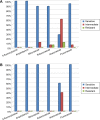Higher diversity in fungal species discriminates children with type 1 diabetes mellitus from healthy control
- PMID: 27143864
- PMCID: PMC4844445
- DOI: 10.2147/PPA.S97852
Higher diversity in fungal species discriminates children with type 1 diabetes mellitus from healthy control
Abstract
Objective: To conduct qualitative and quantitative assessment of yeast-like fungi in the feces of children and adolescents with type 1 diabetes mellitus (T1DM) with respect to their metabolic control and duration of the disease.
Materials and methods: The studied materials included samples of fresh feces collected from 53 children and adolescents with T1DM. Control group included 30 age- and sex-matched healthy individuals. Medical history was taken and physical examination was conducted in the two study arms. Prevalence of the yeast-like fungi in the feces was determined as well as their amounts, species diversity, drug susceptibility, and enzymatic activity.
Results: The yeast-like fungi were found in the samples of feces from 75.4% of T1DM patients and 70% controls. In the group of T1DM patients, no correlation was found between age (Rs=0.253, P=0.068), duration of diabetes (Rs=-0.038, P=0.787), or body mass index (Rs=0.150, P=0.432) and the amount of the yeast-like fungi isolated in the feces. Moreover, no correlation was seen between the amount of the yeast-like fungi and glycated hemoglobin (Rs=0.0324, P=0.823), systolic blood pressure (Rs=0.102, P=0.483), or diastolic blood pressure (Rs=0.271, P=0.345).
Conclusion: Our research has shown that children and adolescents with T1DM show higher species diversity of the yeast-like fungi, with Candida albicans being significantly less prevalent versus control subjects. Moreover, fungal species in patients with T1DM turn out to be more resistant to antifungal treatment.
Keywords: children; diabetes mellitus type 1; drug susceptibility; duration of the disease; metabolic control; yeast-like fungi.
Figures





Similar articles
-
High Interleukin-12 Levels May Prevent an Increase in the Amount of Fungi in the Gastrointestinal Tract during the First Years of Diabetes Mellitus Type 1.Dis Markers. 2016;2016:4685976. doi: 10.1155/2016/4685976. Epub 2016 Dec 29. Dis Markers. 2016. PMID: 28127111 Free PMC article.
-
No effect of yeast-like fungi on lipid metabolism and vascular endothelial growth factor level in children and adolescents with type 1 diabetes mellitus.Ital J Pediatr. 2016 Dec 12;42(1):107. doi: 10.1186/s13052-016-0317-9. Ital J Pediatr. 2016. PMID: 27955676 Free PMC article.
-
Quantitative evaluation of fungi of the genus Candida in the feces of adult patients with type 1 and 2 diabetes - a pilot study.Gut Pathog. 2014 Oct 15;6(1):43. doi: 10.1186/s13099-014-0043-z. eCollection 2014. Gut Pathog. 2014. PMID: 25328543 Free PMC article.
-
[Yeast-like fungi in the gastrointestinal tract in children and adolescents with diabetes type 1].Pediatr Endocrinol Diabetes Metab. 2015;20(4):170-7. doi: 10.18544/PEDM-20.04.0017. Pediatr Endocrinol Diabetes Metab. 2015. PMID: 26615584 Review. Polish.
-
Candida and candidaemia. Susceptibility and epidemiology.Dan Med J. 2013 Nov;60(11):B4698. Dan Med J. 2013. PMID: 24192246 Review.
Cited by
-
The Gut-Liver Axis in Cholestatic Liver Diseases.Nutrients. 2021 Mar 21;13(3):1018. doi: 10.3390/nu13031018. Nutrients. 2021. PMID: 33801133 Free PMC article. Review.
-
Tonsil Mycobiome in PFAPA (Periodic Fever, Aphthous Stomatitis, Pharyngitis, Adenitis) Syndrome: A Case-Control Study.Front Cell Infect Microbiol. 2021 Jan 27;10:616814. doi: 10.3389/fcimb.2020.616814. eCollection 2020. Front Cell Infect Microbiol. 2021. PMID: 33585283 Free PMC article.
-
Diabetes mellitus increases the susceptibility to encephalitozoonosis in mice.PLoS One. 2017 Nov 1;12(11):e0186954. doi: 10.1371/journal.pone.0186954. eCollection 2017. PLoS One. 2017. PMID: 29091912 Free PMC article.
-
Diabetes and gut microbiome.Front Microbiol. 2025 Jan 7;15:1451054. doi: 10.3389/fmicb.2024.1451054. eCollection 2024. Front Microbiol. 2025. PMID: 39839113 Free PMC article. Review.
-
Multiple low-dose radiation ameliorates type-2 diabetes mellitus via gut microbiota modulation to activate TLR4/MyD88/NF-κB pathway.BMC Endocr Disord. 2025 Feb 7;25(1):32. doi: 10.1186/s12902-025-01861-z. BMC Endocr Disord. 2025. PMID: 39920713 Free PMC article.
References
-
- Soyucen E, Gulcan A, Aktuglu-Zeybek AC, Onal H, Kiykim E, Aydin A. Differences in the gut microbiota of healthy children and those with type 1 diabetes. Pediatr Int. 2014;56(3):336–343. - PubMed
-
- Boerner BP, Sarvetnick NE. Type 1 diabetes: role of intestinal micro-biome in humans and mice. Ann N Y Acad Sci. 2011;1243:103–118. - PubMed
LinkOut - more resources
Full Text Sources
Other Literature Sources

